Maeve Brennan
The Long-Winded Lady
Maeve Brennan, Photo by Karl Bissinger
Maeve Brennan (1917 - 1993) was born in Dublin in 1917, and spent her early childhood in a house on Cherryfield Avenue, Ranelagh, Dublin 6, before emigrating to the U.S. with her family as a teenager. She worked at both Harper’s Bazaar and the New Yorker from the 1950s through to the 1970s. Many of her short stories were published at these titles and she became best known to the American public under the pseudonym of ‘The Long-Winded Lady’ via her ‘Talk of the Town’ column at the New Yorker. However, Brennan could not shake off the formative influence that Ireland had on her life, and thus it became the setting of her finest works, which communicate authentic representations of the fear and anxiety that can permeate modern life.
Brennan left behind a legacy of short fiction at her death in 1993; The Springs of Affection: Stories of Dublin, The Rose Garden: Short Stories and the novella The Visitor. Largely unknown in Ireland until the millennium, Brennan has gradually become more recognised as more and more people become interested in her work and life. Brennan’s work has won praise from authors such as John Updike, Alice Munro and Edna O’Brien; she was the subject of a 2004 biography, Maeve Brennan: Homesick at the New Yorker by Angela Bourke, and Emma Donoghue’s play Talk of the Town, which premiered at the 2012 Dublin Theatre Festival, was an imagining of Brennan’s life at the New Yorker.
Brennan’s short stories relate in the most exacting detail the pain, fear and anxiety that can underlie middle-class life in Dublin, and her conception of the lives of her female protagonists gives the reader much to consider on Irish womanhood in the twentieth century. Her stories have an emphasis on inner experience and reject chronological time, flitting from past memories to the present lived experience of the characters.
Perhaps the most pervasive theme in Brennan’s work (fittingly as an emigrant writer in the vein of Joyce and Beckett) is that of the home, and the fear of exile or displacement. The house on Cherryfield Avenue was to prove a constant presence in her work, as she details the lives of three families living in Ranelagh in her most famous work, the short story collection, The Springs of Affection; Stories of Dublin. Brennan’s definition of the home in The Visitor illustrates Brennan’s insight and beauty as a writer, as well the essential relationship between home and emotional wellbeing,
“Home is a place in the mind. When it is empty it frets. It is fretful with memory, faces and places and times gone by. Beloved images rise up in disobedience and make a mirror for emptiness” (Brennan, The Visitor).
Ciara Fitzpatrick

